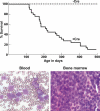The Ews-ERG fusion protein can initiate neoplasia from lineage-committed haematopoietic cells
- PMID: 15974803
- PMCID: PMC1159166
- DOI: 10.1371/journal.pbio.0030242
The Ews-ERG fusion protein can initiate neoplasia from lineage-committed haematopoietic cells
Abstract
The EWS-ERG fusion protein is found in human sarcomas with the chromosomal translocation t(21;22)(q22;q12), where the translocation is considered to be an initiating event in sarcoma formation within uncommitted mesenchymal cells, probably long-lived progenitors capable of self renewal. The fusion protein may not therefore have an oncogenic capability beyond these progenitors. To assess whether EWS-ERG can be a tumour initiator in cells other than mesenchymal cells, we have analysed Ews-ERG fusion protein function in a cellular environment not typical of that found in human cancers, namely, committed lymphoid cells. We have used Ews-ERG invertor mice having an inverted ERG cDNA cassette flanked by loxP sites knocked in the Ews intron 8, crossed with mice expressing Cre recombinase under the control of the Rag1 gene to give conditional, lymphoid-specific expression of the fusion protein. Clonal T cell neoplasias arose in these mice. This conditional Ews gene fusion model of tumourigenesis shows that Ews-ERG can cause haematopoietic tumours and the precursor cells are committed cells. Thus, Ews-ERG can function in cells that do not have to be pluripotent progenitors or mesenchymal cells.
Figures





Similar articles
-
Mll fusions generated by Cre-loxP-mediated de novo translocations can induce lineage reassignment in tumorigenesis.EMBO J. 2005 Sep 7;24(17):3136-46. doi: 10.1038/sj.emboj.7600760. Epub 2005 Aug 11. EMBO J. 2005. PMID: 16096649 Free PMC article.
-
EWS-FLI1, EWS-ERG, and EWS-ETV1 oncoproteins of Ewing tumor family all suppress transcription of transforming growth factor beta type II receptor gene.Cancer Res. 2000 Mar 15;60(6):1536-40. Cancer Res. 2000. PMID: 10749119
-
Identification of various exon combinations of the ews/fli1 translocation: an optimized RT-PCR method for paraffin embedded tissue -- a report by the CWS-study group.Klin Padiatr. 2004 Nov-Dec;216(6):315-22. doi: 10.1055/s-2004-832338. Klin Padiatr. 2004. PMID: 15565546
-
Complex rearrangement of chromosomes 19, 21, and 22 in Ewing sarcoma involving a novel reciprocal inversion-insertion mechanism of EWS-ERG fusion gene formation: a case analysis and literature review.Cancer Genet Cytogenet. 2008 Mar;181(2):81-92. doi: 10.1016/j.cancergencyto.2007.11.002. Cancer Genet Cytogenet. 2008. PMID: 18295659 Review.
-
Recent advances in T-cell lymphoid neoplasms.Exp Hematol. 2022 Feb;106:3-18. doi: 10.1016/j.exphem.2021.12.191. Epub 2021 Dec 5. Exp Hematol. 2022. PMID: 34879258 Review.
Cited by
-
EWS-FLI1 induces developmental abnormalities and accelerates sarcoma formation in a transgenic mouse model.Cancer Res. 2008 Nov 1;68(21):8968-75. doi: 10.1158/0008-5472.CAN-08-0573. Cancer Res. 2008. PMID: 18974141 Free PMC article.
-
Ewing sarcoma gene Ews regulates hematopoietic stem cell senescence.Blood. 2011 Jan 27;117(4):1156-66. doi: 10.1182/blood-2010-04-279349. Epub 2010 Oct 28. Blood. 2011. PMID: 21030557 Free PMC article.
-
Mll fusions generated by Cre-loxP-mediated de novo translocations can induce lineage reassignment in tumorigenesis.EMBO J. 2005 Sep 7;24(17):3136-46. doi: 10.1038/sj.emboj.7600760. Epub 2005 Aug 11. EMBO J. 2005. PMID: 16096649 Free PMC article.
-
Downstream EWS/FLI1 - upstream Ewing's sarcoma.Genome Med. 2010 Jan 28;2(1):8. doi: 10.1186/gm129. Genome Med. 2010. PMID: 20156317 Free PMC article.
-
Recent advances in the molecular pathogenesis of Ewing's sarcoma.Oncogene. 2010 Aug 12;29(32):4504-16. doi: 10.1038/onc.2010.205. Epub 2010 Jun 14. Oncogene. 2010. PMID: 20543858 Free PMC article. Review.
References
-
- Rabbitts TH. Chromosomal translocations in human cancer. Nature. 1994;372:143–149. - PubMed
-
- Look AT. Oncogenic transcription factors in the human acute leukemias. Science. 1997;278:1059–1065. - PubMed
-
- Mitelman F, Johansson B, Mertens F, editors. Mitelman Database of Chromosome Aberrations in Cancer [database] Bethesda (Maryland): National Cancer Institute; 2000. Available: http://cgap.nci.nih.gov/Chromosomes/Mitelman. Accessed 19 May 2005.
-
- Huntly BJ, Gilliland DG. Leukaemia stem cells and the evolution of cancer-stem-cell research. Nat Rev Cancer. 2005;5:311–321. - PubMed
-
- Gale RP, Grosveld G, Canaani E, Goldman JM. Chronic myelogenous leukemia: Biology and therapy. Leukemia. 1993;7:653–658. - PubMed
Publication types
MeSH terms
Substances
LinkOut - more resources
Full Text Sources
Other Literature Sources
Molecular Biology Databases

